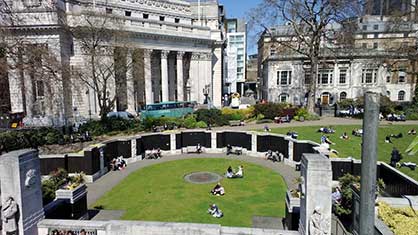During the world wars, the British civilian navy’s duty was to be the supply service of the Royal Navy. This merchant navy transported troops and supplies to the armies, as well as raw materials to overseas munitions factories and the assembled munitions from those factories. It also did its best to maintain, on a reduced scale, the ordinary import and export trade, in order to supply food to the home country. In spite of greatly enlarged risks and responsibilities, it also provided both personnel and ships to supplement the existing resources of the Royal Navy.
Losses of merchant vessels were high from the outset, but had peaked in 1917 when, in January, the German government announced the adoption of "unrestricted submarine warfare." The subsequent preventative measures introduced by the Ministry of Shipping, including the setting up of the convoy system where warships were used to escort merchant vessels, led to a decrease in losses. Despite this, by the end of the war, 3,305 merchant ships had been lost and 17,000 sailors had lost their lives.
In the Second World War, losses were again considerable in the early years, reaching a peak in 1942. The heaviest losses were suffered in the Atlantic, but convoys making their way to the Soviet Union around Norway’s North Cape, and those supplying Malta in the Mediterranean were also particularly vulnerable to attack. In all, 4,786 merchant ships were lost during the war and 32,000 sailors were killed. More than one quarter of this total were lost in Britain’s home waters.
The First World War section of the Tower Hill Memorial commemorates almost 12,000 Merchant Marine casualties who have no grave but the sea. The Memorial was designed by Sir Edwin Lutyens with sculpture by Sir William Reid-Dick. It was unveiled by Queen Mary on December 12, 1928.
The Second World War extension, which commemorates almost 24,000 casualties, was designed by Sir Edward Maufe, with sculpture by Charles Wheeler. It was unveiled by Queen Elizabeth II on November 5, 1955.
The memorial displays 35,746 names. Of these, 480 are Canadians who served with the Merchant Navy (409 from the First World War and 71 from the Second World War). They are all commemorated in Canada’s Merchant Navy Book of Remembrance.
Directions
The Tower Hill Memorial stands on the south side of the garden of Trinity Square, in London, close to the Tower of London. It is a hundred yards east of Mark Lane Station, and just within the boundaries of the Metropolitan Borough of Stepney and the Liberty of the Tower. It is at the hub of maritime England. Behind it are Trinity House and the offices of the Port of London Authority, and the Thames stretches before it. The wide space of Great Tower Hill, leading down from it to the river, is the traditional forum of merchant seamen and their fellow workers. Lloyd’s is on the north, the Custom House and Billingsgate Market are near it on the west, and beyond the Tower, eastward, is the long line of the Docks—the greatest dock system in the world.

